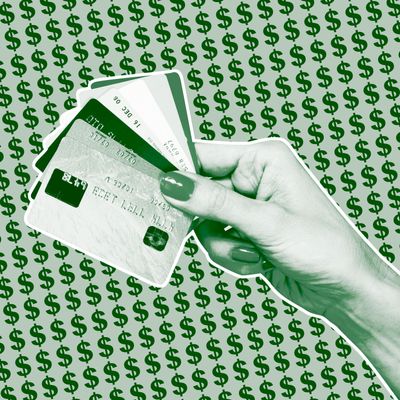
Hello, it’s me, your credit card. I don’t want to presume anything, but it seems like we’ve been pretty tight lately. Wasn’t I there for you last night, when you panic-bought all your Christmas presents and paid extra for express shipping? And last weekend, when you had too much mulled wine at your umpteenth holiday party, lost your phone, and had to hail an actual yellow cab — with your arm! — to get home? And again the next morning, when you needed a bacon, egg, and cheese delivered to your door immediately upon waking? Don’t worry, I’ll have your back next week, too, when your holiday travel plans go awry and you have a fight with your airline over missing bags.
I’ve heard I can be smothering — easy to get close to and then impossible to get rid of. But I can’t help it if you don’t make boundaries! I just love a good time, and the holidays are when I truly shine.
Come January, you’ll want some space. I respect that — it’s healthy. But I should warn you that it’s not easy to extricate yourself from our relationship. A recent survey from WalletHub showed that about 25 percent of Americans are still paying off holiday debt from last year, thanks in part to credit-card interest rates hitting record highs. So don’t be embarrassed to be seen with me or anything; you’re in good company.
If you really do want to cut ties and get your finances under control, though, here are the steps to pay me off. Just don’t say I never helped you out.
Take stock of the damage.
In all seriousness, credit cards make it easy to lose track of how much you’ve spent, especially in the free-for-all that is this holiday season. It’s also normal to bury your head in the sand when your bills get overwhelming. But you can’t solve a problem unless you know exactly what it is — or, in this case, how much. To cut to the chase: Look at your balances.
While you’re at it, go through your statements line by line. This will serve two purposes: (1) You’ll see what expenses you could do without (you’re still paying for that streaming service you signed up for to watch that one show and then forgot about, oops), and (2) you can ferret out erroneous or fraudulent charges. This is a good habit to have more generally, too.
Last but not least, check your APR, also known as the interest rate on your credit-card balance. It’s probably higher than you think. Credit-card companies usually aren’t allowed to raise your APR on existing purchases, but there are some very notable exceptions, says Beverly Harzog, a consumer-finance analyst at U.S. News and World Report. “When the Fed raises interest rates, your APR usually goes up too,” she explains. Technically you’re supposed to get a 45-day warning before this happens, but who opens mail from credit-card companies? The bottom line is that your outstanding credit-card debt is compounding even more quickly than usual, so you should attend to it ASAP.
Know your credit score.
Credit-card debt doesn’t necessarily hurt your credit score — in fact, plenty of people with lots of debt maintain great credit. (Conversely, lots of people with no debt have low scores, but we don’t need to get into that right now.) The important thing is to keep your score as high as possible because it will improve your options for paying off debt when you have it, among other benefits.
If your score is good (usually over 670, although over 720 is “very good”), then you’ll have a range of choices. One is that you could simply call your credit-card company and ask them to reduce your APR or increase your credit limit, which can boost your credit score and improve your options further. “If you have a great credit history, it’s worth trying,” says Harzog. “But if your credit is more spotty or you’ve missed a payment recently, you don’t want to call attention to yourself — I know someone who tried that and the company lowered his credit limit instead.”
An even better option for those with strong credit is to apply for a balance-transfer card, which is a type of credit card that charges no interest for a fixed period of time. It enables you to roll over part or all of your existing debt and then pay it down more quickly because it isn’t accruing interest (a.k.a. growing). But you need to be strategic because once the zero-APR period is up (usually after six months to a year), the rate can rise very quickly, adds Harzog.
If your credit score isn’t quite good enough to qualify for a zero-interest balance-transfer card, your next best bet is a debt-consolidation loan. “You’re not going to get 0 percent interest on a debt-consolidation loan, but you will most likely get lower interest than what you’re paying on your credit card,” says Harzog. You would then use the money from the loan to pay off your higher-interest credit-card debt and then work on paying off the lower-interest loan.
Obviously, none of this is a magic fix, but slowing down the growth of your debt can help you get out of it faster and save you a lot of money while you do.
Make a plan.
Once you’ve gotten a handle on your credit score and what options are available to you, plot out your steps for the hard part: shoveling money at your bills. This will be a slog, so it’s smart to have a strategy and break it down into achievable chunks.
There are three popular methods for dealing with debt in multiple accounts or cards. The one that saves the most money is known as the “avalanche” method, which involves tackling your highest-interest debt first and working your way down. Objectively, this is the wisest from a math perspective. But a more popular alternative is the “snowball” method, which involves starting with the lowest balance first and working your way up. “The snowball method is known to provide a psychological boost because you feel encouraged by knocking off an account,” says Harzog. “If that works for you, then do it.”
The third method, which Harzog invented herself, is known as the “blizzard” (don’t ask me why these all sound so cold): “You start with the snowball method, so you hit the smallest balance first and get the quick win, and then you switch to the avalanche after that to save money on interest,” she says. Ultimately, you should pick whatever you’ll stick to.
Hang in there!
It’s easy to get discouraged by credit-card debt. Interest rates are still high, the economy is still weird, and there are many reasons to YOLO your way through this month and deal with the financial fallout later. The most important thing to remember is that you’re not alone, and you shouldn’t be shy about asking for support as you get yourself back on your feet.
“I get emails from people all the time asking me for help because they’re drowning in debt,” says Harzog. “Sometimes all they need is a phone call to help them focus on the next steps.” If you don’t have a trusted friend or family member to talk to, she suggests reaching out to the National Foundation for Credit Counseling or the Financial Counseling Association of America, both of which are non-profit organizations that will provide initial guidance for free. (Beware of debt-settlement or debt-relief agencies, many of them are predatory.) “Above all, be patient,” she says. “You didn’t accrue this debt overnight, and you won’t get out of debt overnight either.”
This post has been updated.
The Cut’s financial advice columnist Charlotte Cowles answers readers’ personal questions about personal finance. Email your money conundrums to mytwocents@nymag.com





